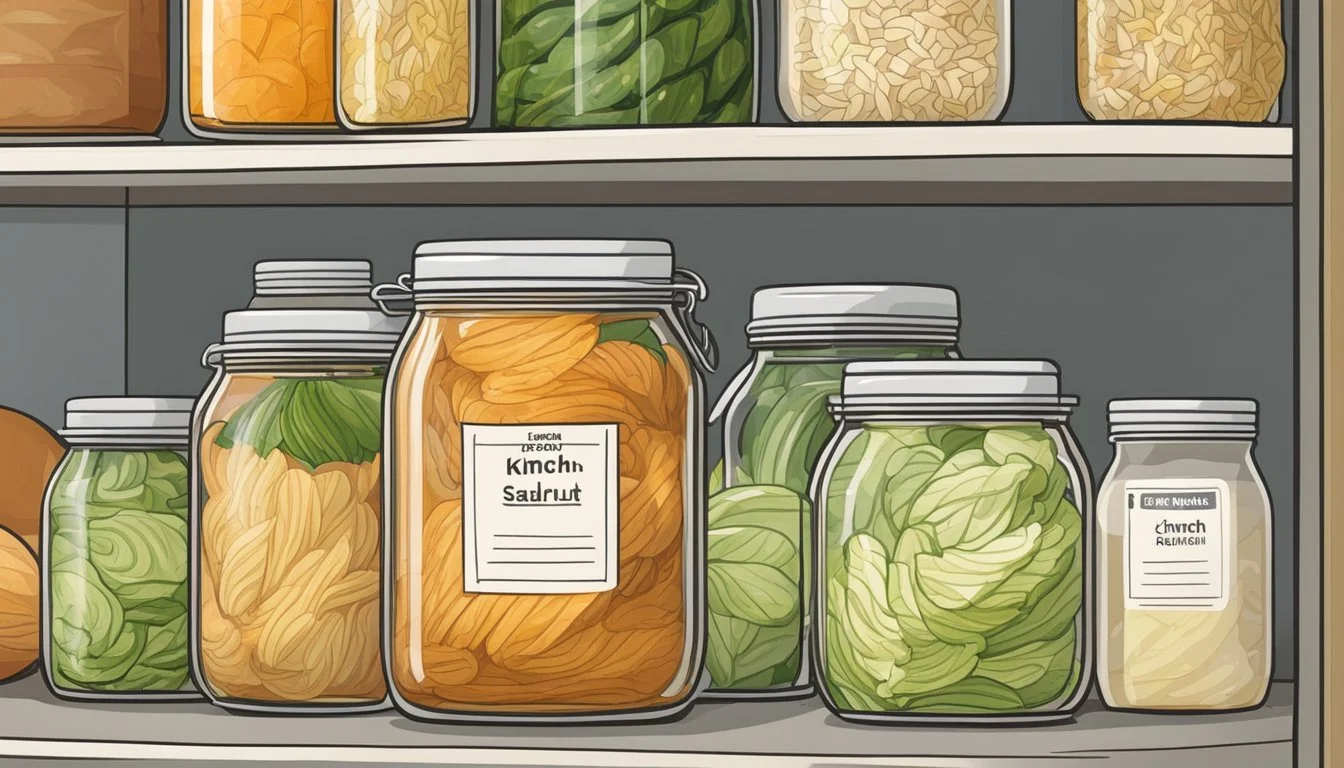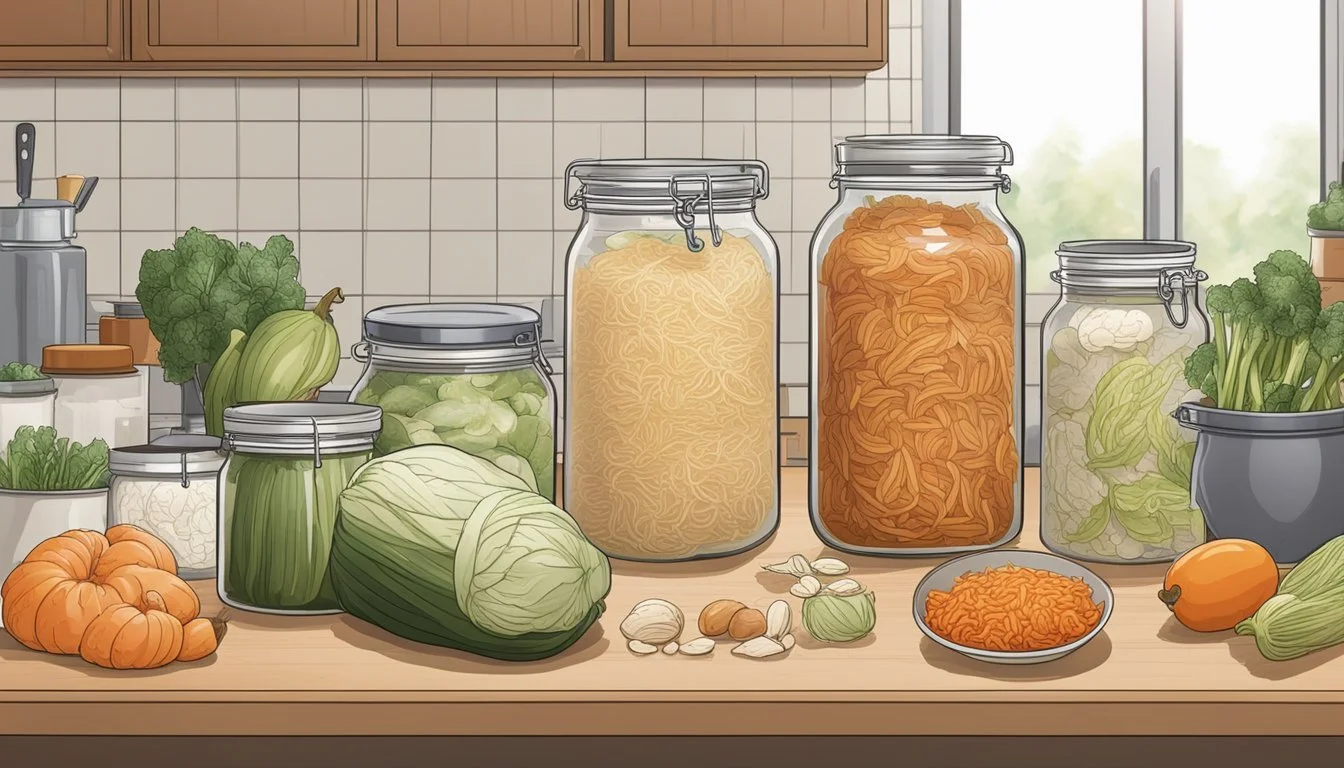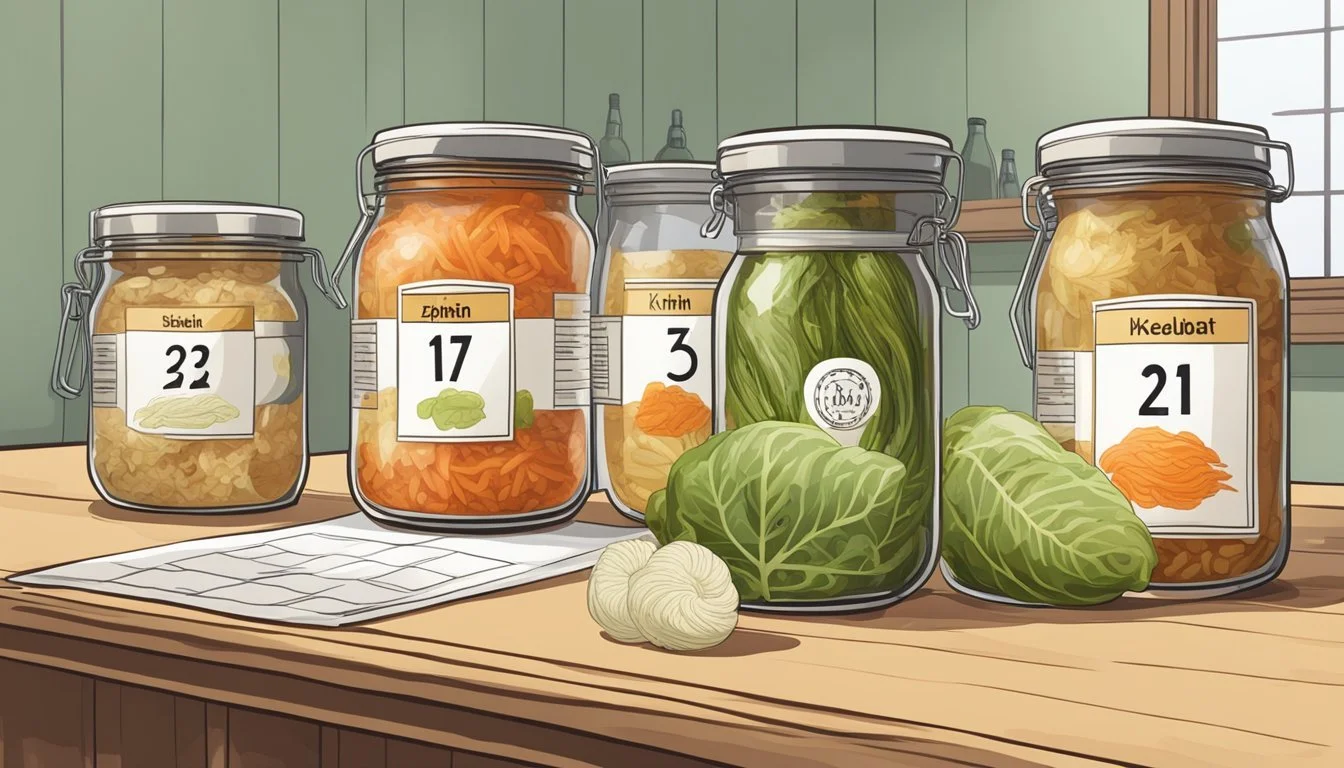How Long Does Kimchi and Sauerkraut Last?
Shelf Life Explained
Kimchi and sauerkraut, both staples originating from distinct cultures, share the common process of fermentation that not only extends their shelf life but also enhances their flavors. The lacto-fermentation process, where lactic acid bacteria turn sugars into lactic acid, acts as a natural preservative. This method is traditional for Korean kimchi, which combines cabbage with various seasonings, and for German sauerkraut, solely consisting of salted cabbage.
The longevity of these fermented foods is significantly influenced by the fermentation duration, salt concentration, and storage conditions. Kimchi, with a vibrant array of spices and a robust taste, usually maintains its quality for up to 1-2 months when homemade and kept refrigerated. Its shelf life can push to approximately 3 months if it has a higher salt or vinegar content, which acts as additional preservatives.
In comparison, sauerkraut's shelf life varies depending on its preparation. Typically, it is left to ferment for about 6-8 weeks in cool environments, and once jarred and refrigerated, sauerkraut can remain edible for several months. Store-bought versions have an even longer shelf life, often retaining their quality well beyond their best-by dates when unopened and refrigerated. The exact duration will depend on factors such as the presence of preservatives and the specifics of the fermentation process used.
Fundamentals of Fermentation
Fermentation forms the cornerstone of creating traditional dishes like kimchi and sauerkraut, offering numerous health benefits through the proliferation of probiotics.
Process of Fermentation
The fermentation process is primarily anaerobic, allowing bacteria to convert sugars and starches in vegetables into lactic acid. Lactobacillus, a beneficial bacterium, plays a significant role in this transformation, creating an acidic environment that preserves the vegetables and imparts a tangy flavor.
Common Ingredients
Key ingredients for sauerkraut include thinly sliced green cabbage and salt. Kimchi often consists of napa cabbage, radish, fish sauce, garlic, ginger, gochugaru (Korean red pepper flakes), and a variety of other spices. Both dishes can accommodate a range of additional vegetables and seasonings based on regional or personal preferences.
Health Benefits
These fermented foods are rich in probiotics which support gut health. They are also typically low-carb and can be suitable for a vegan diet. Regular consumption of kimchi and sauerkraut may contribute to a strengthened immune system and improved digestion.
Cultural Significance
In Korean cuisine, kimchi is more than a side dish; it is a cultural emblem with historical significance. Similarly, sauerkraut holds a storied place in several European traditions. Both are prepared with reverence to tradition, often associated with family and community.
Variations of Kimchi and Sauerkraut
There exist many types of kimchi, ranging from the traditional made with napa cabbage to versions using daikon radish or other vegetables. Sauerkraut variations may include caraway seeds or be altered for a gluten-free or vegan diet, demonstrating versatility.
Global uses and Adaptability
Sauerkraut and kimchi have been adapted globally, transcending their cultural origins. They are used as condiments, side dishes, or flavor enhancers in various global cuisines. Both can also serve as a substitute for one another depending on dietary needs and flavor profiles desired.
Preserving Quality and Taste
The key to maintaining the quality and taste of kimchi and sauerkraut lies in optimal storage conditions, recognizing the signs of spoilage, and employing techniques to extend shelf life.
Optimal Storage Conditions
For kimchi and sauerkraut, the refrigerator offers the best environment for preservation. Keeping these fermented foods in an airtight container made of glass or plastic can help maintain quality. Optimal temperature in the fridge should be kept around 32°F to 39°F (0°C to 4°C). A constant cool temperature slows down fermentation, preserving the product's taste, texture, and umami qualities.
Kimchi
Texture should remain crisp.
Smell is typically a vibrant, tangy scent.
Sauerkraut
Taste should stay tangy without becoming excessively sour.
Appearance is crucial, with a light color being ideal.
Avoid storing near strong-smelling foods, as kimchi and sauerkraut can absorb odors.
Signs of Spoilage
Spoilage in kimchi and sauerkraut can be detected primarily by three signs: smell, taste, and appearance. Any deviations from their usual tangy and pungent scent, such as an off-smell or the presence of mold, likely indicate spoilage. Visually, if the product looks discolored or slimy, it is no longer good to eat. The taste should be sour but not unpleasantly so; any bitter or off flavors suggest the food is past its prime and may cause food poisoning.
Kimchi
Smell: Offensively sour or presence of mold.
Appearance: Discoloration or slimy texture.
Sauerkraut
Taste: Noticeably bitter.
Texture: Mushy instead of crisp.
Techniques to Extend Shelf Life
To extend the shelf life of kimchi and sauerkraut:
Use clean utensils each time to prevent contamination.
Keep the product submerged in its juice within the airtight jar or container.
An additional technique for kimchi is:
Adding extra vinegar can act as a preservative and lengthen shelf life.
For longer storage:
Freezing is an option, although it may alter the texture upon thawing.
Kimchi
Can be stored in freezer for up to 3 months.
Green onion or other additional spices should be fresh to prevent early spoilage.
Sauerkraut
Store away from light in a cellar or similar cool climate-controlled environment, if not using a refrigerator.
Sensory Characteristics and Flavor Development
The development of flavor and sensory characteristics in kimchi and sauerkraut is a dynamic process influenced by fermentation time, ingredients, and temperature.
Stages of Flavor Maturation
In kimchi, flavor development begins shortly after the fermentation process starts, intensifying over time. Initially, the taste is fresh and mildly spicy, but as kimchi ferments, its taste becomes significantly sour and umami tones develop. Typically, the flavor matures fully in about two weeks at room temperature. Sauerkraut also undergoes flavor maturation, taking longer periods, often 6 to 8 weeks, before reaching its peak. The taste gradually transitions from salty to a distinguishable tangy and tart profile.
Impact of Ingredients on Taste
Ingredients play a crucial role in shaping the flavor profile of both fermented foods. Kimchi relies on fish sauce, garlic, ginger, and chili powder to create a complex, spicy, and umami-rich flavor. Green onions, radishes, and additional seasonings like sugar may add hints of sweetness, balancing the overall taste. In contrast, sauerkraut is more simplistic, focusing on cabbage and salt. However, the introduction of caraway seeds or juniper berries in some recipes can introduce subtle spice notes.
Texture Composition and Palate
Kimchi exhibits various textures depending on its fermentation stage, starting from a crunchy bite in its early stages to a softer consistency as it ferments. The presence of bubbles and a slight fizz can indicate active fermentation and contribute to a unique sensory experience. Sauerkraut, on the other hand, emphasizes a crisp texture that may soften over extended periods while maintaining its crunch. Acidity levels rise as both kimchi and sauerkraut ferment, impacting not just the flavor but the texture, resulting in an appealing contrast on the palate.
Home Fermentation Guide
In exploring the preservation of homemade kimchi and sauerkraut, one must understand the crucial steps in the fermentation process, how to prevent contamination, and methods for addressing common issues.
Step-by-Step Fermentation Process
To commence fermentation, one must ensure clean utensils and prepare vegetables, such as cabbage, by cutting and combining them with salt to create a brine. In the case of sauerkraut, cabbage is massaged with salt until brine is produced, which covers the vegetable pieces when packed into an airtight container. Kimchi requires a mixture of seasonings and vegetables that are packed into a container and also pressed under the brine.
Fermenting time varies based on the temperature and desired sourness level:
Sauerkraut may take 1 to 6 weeks.
Kimchi typically ferments within 2 days to 1 week.
Fermentation should occur at a consistent room temperature, ideally between 68-72°F. Once fermented, both kimchi and sauerkraut are stored in the refrigerator to slow down the fermentation process.
Safety Tips and Contamination Prevention
Food safety is paramount. One must always start with clean utensils and containers to minimize the risk of contamination. When preparing the brine, ensure the use of non-iodized salt, as iodine can inhibit fermentation.
Key points include:
Always keep the vegetables submerged in brine to prevent mold and exposure to air.
Store the fermenting containers away from direct sunlight and maintain a stable temperature.
Troubleshooting Common Issues
Throughout the fermentation process, a vigilant eye can catch and correct several common issues:
Issue Resolution Mold Growth Scrape off the mold; if the smell and taste are unaffected, the rest is still edible. Surface Yeast Skim off the yeast; ensure the vegetables remain submerged in brine. Cloudy Brine Common during fermentation and typically not a concern unless accompanied by off smells.
In case of unpleasant odors or discoloration beyond the surface, it is better to err on the side of caution and dispose of the batch to avoid potential foodborne illness.
Dietary Considerations and Substitutions
When incorporating kimchi and sauerkraut into diets, one must consider dietary restrictions and potential substitutions to accommodate allergies and preferences.
Kimchi and Sauerkraut in Dietary Restrictions
Kimchi often includes a variety of vegetables such as cabbage, radishes, and scallions, and is seasoned with spices like chili pepper flakes, garlic, ginger, and fish sauce or seafood. For those with seafood allergies or adhering to a vegan diet, it's crucial to substitute fish sauce or seafood with soy sauce or miso paste, which are plant-based umami-rich alternatives.
Sauerkraut, traditionally made with thinly sliced cabbage and salt, is fermented over several weeks. It's naturally gluten-free, and because it doesn't typically contain fish sauce or seafood, it's suitable for vegans. However, as it can be quite salty, those on sodium-restricted diets may want to limit their intake or rinse it before use to reduce the sodium content.
Both kimchi and sauerkraut rely on pickling as a preservation method, which is reliant on salt. Individuals seeking lower salt options may want to create homemade versions to better control the amount of salt used.
When considering allergies, it's essential to review all the ingredients as spices and other components used in the pickling process may contain allergens. Regardless of dietary preferences, one can often find or make suitable versions of these fermented veggies, ensuring they can enjoy the health benefits without the dietary downsides.
Commercial Production and Buying Guide
When purchasing kimchi or sauerkraut, it's important to consider factors like quality, shelf life, and production methods. This section will guide readers through selecting high-quality fermented foods, how they compare to homemade batches, and understanding product labeling.
Selecting High-Quality Fermented Foods
When shopping for fermented cabbage such as kimchi and sauerkraut, look for products that have a vibrant color and a fresh fermented scent. High-quality fermented foods should not have any additives or preservatives, which can affect their authentic taste and potentially their shelf life. The shelf life for store-bought kimchi and sauerkraut varies but typically kimchi can last for several months in the fridge, whereas sauerkraut can last for 6 to 8 weeks after opening if refrigerated properly. For the best flavor profile, opt for organic and non-GMO labeled products as these are often produced with higher quality standards.
Kimchi: Several months in fridge
Sauerkraut: 6-8 weeks in fridge after opening
Comparison of Homemade vs. Store-Bought
Homemade kimchi and sauerkraut allow for customization of flavor and spice levels, and one can ensure the use of fresh, organic ingredients without unnecessary chemicals. However, homemade varieties may have a shorter shelf life due to the absence of commercial preserving techniques. Store-bought fermented foods offer convenience and a shelf-stable option when properly sealed and preserved. They might include additional preservatives extending their shelf life. It's important to weigh the quality, price, and expiration date while making a choice.
Homemade: Fresher taste, shorter shelf life
Store-bought: Longer shelf life, possible additives
Understanding Product Labeling
Product labels provide essential information about the fermented food. Look for the "best before" or expiration date to gauge freshness. Labels should also identify whether the product is organic, non-GMO, or contains any additives or preservatives. Understanding labels is crucial to ensure you are purchasing high-quality, safe, and suitable products for your needs.
"Best before": Assess freshness
Organic/Non-GMO: Indicates higher quality standards
Conservation and Longevity
The shelf life of kimchi and sauerkraut is greatly impacted by storage conditions and methods. This section focuses on how to preserve these fermented vegetables well beyond their typical expiration date, estimate their lifespan, and understand the effects of freezing versus refrigeration.
Preserving Beyond Typical Shelf Life
For kimchi, an optimal preservation method involves storing it in a refrigerator at temperatures just above freezing, in a tightly sealed container to prevent oxidation. Sauerkraut, similarly, has its longevity preserved under refrigeration, ideally at or below 40°F. Both kimchi and sauerkraut can last upwards of three months when cared for in these conditions.
At room temperature: Kimchi typically lasts about 1 week after opening.
Refrigeration: Extends kimchi's shelf life to several months in an airtight container.
Sauerkraut: Should always be refrigerated to extend its shelf life.
Estimating the Lifespan of Fermented Vegetables
Fermented vegetables such as kimchi and sauerkraut have a shelf life that exceeds many other food products due to the fermentation process. To accurately estimate their lifespan, one must consider:
The strength and activity level of the fermentation.
The temperature and consistency of the storage environment.
How well the container seals out oxygen.
Freezing versus Refrigeration
While freezing kimchi and sauerkraut can extend their shelf life, it may affect their texture and taste.
Freezer: Use for long-term storage, but expect some change in texture.
Refrigerator: Preferred for maintaining original texture and taste.
Temperature: Consistent low temperatures slow down fermentation and prevent spoilage.
When shifting from freezer to refrigerator, it's crucial to thaw slowly to minimize texture changes.
FAQs and Myths about Kimchi and Sauerkraut
Exploring the longevity, health implications, and flavor characteristics of kimchi and sauerkraut unravels a wealth of facts and dispels common myths surrounding these popular fermented foods.
Addressing Common Questions
How long do kimchi and sauerkraut last?
Freshly made kimchi typically lasts in the refrigerator for about 1 week and can remain edible for several months when properly stored. Sauerkraut, with its longer fermentation process, generally has a shelf life of several months to a year under refrigeration once opened.Can fermented foods like kimchi and sauerkraut aid in weight loss?
Both kimchi and sauerkraut are low in calories and high in fiber, which can promote satiety and potentially aid in weight loss. However, they should be consumed as part of a balanced diet.What differentiates the taste and flavor profile of kimchi from sauerkraut?
The flavor profile of kimchi is often spicy and complex due to the addition of ingredients like chili peppers and garlic, while sauerkraut offers a tangy and sometimes crunchy experience, mainly deriving its flavor from fermented cabbage and salt.Do kimchi and sauerkraut offer health benefits?
Yes, both are rich in probiotics which support gut health. Moreover, they contain vitamins A, C, and K, and according to existing research, they may boost the immune system. It's important, however, to acknowledge that health benefits can vary between individuals.Does the cabbage type affect the shelf life and taste?
The type of cabbage and its preparation can influence both shelf life and taste. For instance, napa cabbage is commonly used for kimchi, adding to its unique taste, whereas sauerkraut is typically made from green cabbage, which may influence its distinct flavor and possibly its longevity.
Conclusion
When properly stored, both kimchi and sauerkraut offer impressive shelf lives due to the preservation nature of the fermentation process. Kimchi typically can last up to 6 months in the refrigerator, while sauerkraut may remain good for anywhere between 6 to 8 weeks when stored in a cool cellar.
Kimchi: Up to 6 months in the fridge
Sauerkraut: 6-8 weeks in a cool environment
The longevity of these fermented foods is enhanced in specialized storage conditions, such as a dedicated kimchi refrigerator, which is common in Korea. These appliances help to maintain a stable temperature, critical for controlling the fermentation rate and extending shelf life even further.
The health benefits of both kimchi and sauerkraut stem primarily from their rich probiotic content, resulting from the activity of lactic acid bacteria during fermentation. These benefits include:
Improved digestion
Enhanced immune function
In terms of nutritional content, sauerkraut typically provides a low-calorie option that is high in vitamin C, vitamin K, and minerals such as manganese, copper, potassium, and folate.
Storage tips for maximizing the shelf life of kimchi and sauerkraut include:
Seal containers tightly to prevent oxidization.
Refrigerate at a consistent, cold temperature.
It is essential for consumers to observe proper food safety practices and be attentive to any signs of spoilage, such as off odors or mold, regardless of the „best by” dates, to ensure that they are consuming these fermented foods at their best quality and state of preservation.








